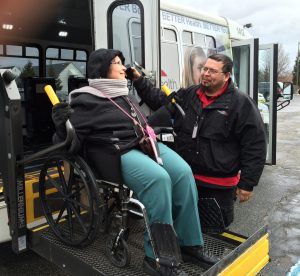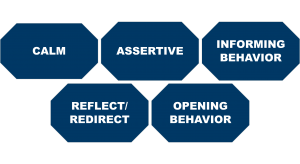Strategies for Working with Difficult Passengers
Strategies for Working with Difficult Passengers
Published on: June 27, 2023
One challenge transit workers face is passengers who may be or become difficult or be in a difficult situation. Unfortunately, during the Covid pandemic, assaults on transit operators escalated. In February 2021, the Federal Transit Administration (FTA) held a webinar addressing the issue of transit worker assault. The FTA held another webinar on May 10, 2023 on proposed new requirements to improve transit worker safety. In addition, FTA is proposing new safety requirements under the Bipartisan Infrastructure Law that would update the Public Transportation Agency Safety Plan (PTASP) rule. A Notice of Proposed Rulemaking (NPRM) was published in the Federal Register on April 26, 2023 and FTA is seeking public comment until June 26, 2023.
This article provides strategies for diffusing conflict and preventing issues.
Causes of Passenger Conflict: Unmet Needs

To discuss root causes of a lot of passenger conflict, it would be a good idea to consider the basic needs of passengers. So, what are basic expectations passengers have when it comes to their public transportation service?
- Friendly Transit Staff: Passengers like to feel their local transit system cares about them and is willing to assist in any way they can. Passengers want to be heard and have their questions politely answered.
- Reliable Service: Passengers like assurance that their transit system will get them to where they need to be in a timely manner.
- Safety: Along with getting passengers to their destination in a timely manner, they also want to feel safe while onboard.
- Clean Vehicles: Along with a sense of safety, passengers want to ride vehicles that are clean and well kept.
- Affordable Fares: Passengers need to have affordable public transit available to them.
- Ease of Use: Passengers want a transit system that is easy to navigate and schedule rides.
When a passenger feels like their basic needs are not being met, conflict can ensue. Of course, there could be other reasons for conflict, such as certain passenger traits. A passenger under the influence of drugs or alcohol could act out. Passengers may be experiencing difficulties with mental health. Sometimes a passenger is simply having a bad day. Perhaps they received bad news about their health or the health of a loved one or lost their job. Avoiding a conflict is not always possible, but there are certain steps a transit agency can take to help smooth over a difficult passenger or situation.
CAIRO Method
What can a transit operator do to de-escalate a difficult situation involving a passenger? The CAIRO method is a useful tool that was developed to help diffuse conflict.
- CALM: The first step in the CAIRO method is to remain calm. If a driver responds to an irate passenger with a raised voice or defensive stance, this will only escalate the conflict and the passenger may view that as being challenged. Instead, the driver should resist the natural reaction to also respond aggressively and get defensive and instead consistently use a calm, neutral tone of voice when speaking to the passenger. If the driver feels they are starting to get defensive, they should acknowledge that is occurring, slow down, take a deep breath, and respond neutrally.
- ASSERTIVE: When responding to conflict, a driver could chose to be either aggressive or assertive. Aggressive means likely to attack or be confrontational whereas assertive means showing confidence. Being assertive, along with having a calm demeanor, can stabilize a contentious situation or passenger. It is best to take a middle of the road approach; that way the driver shows they are not afraid but also that they are not attacking the passenger either.
- INFORMING BEHAVIOR: Effectively communicating can be key in helping to calm down an irate passenger, including using “we” phrases and not “you” phrases. For example, instead of a driver saying “you must take a seat right now!,” try saying “we will be able to move and get on our way once everyone is seated.”
- REFLECT/REDIRECT: When a passenger is voicing displeasure, the driver should actively listen to the passenger, let them vent, and not interrupt them. Let the passenger know they were heard and acknowledge their frustration. This is called reflective listening. Sometimes a passenger just needs to feel they were acknowledged. After reflective listening, the driver should follow-up with a statement, such as “I understand your frustration that you are going to be late for work (reflective), I will do my best to get you there safely and on time.”
- Opening Behavior: Using opening behavior means that the driver tries to make a personal connection to the irate passenger. Sometimes just asking a person what their name is may help diffuse a situation. Many times people respond positively when they hear their name, and it can help interrupt their negative thought pattern.
Other good strategies to keep in mind may be for the driver to handle the situation from their driver’s seat if at all possible. This could help contain the situation and avoids invading the passenger’s personal space (and the driver’s personal space). Drivers should also use non-threatening body language which can help project a sense of control and calm.
Safety Management Plans
The FTA provided guidance on how agencies should address this issue in their Safety Management System (SMS) plans. In November 2021, Congress passed H.R. 3684 – the Infrastructure Investment and Jobs Act, which in part now requires the formation of safety planning committees (Section 30012) for recipients of Section 5307, urbanized area formula grants. These safety plans, while not yet required for Section 5311 rural area formula grants, are strongly encouraged.
Conclusion
While utilizing various de-escalation skills is highly effective in dealing with difficult passengers, it isn’t foolproof and doesn’t work in every situation. If all else fails, the driver needs to recognize the serious red flags and take precautions to protect himself/herself and the safety of fellow passengers by trying to maintain a safe distance and calling the authorities and/or dispatch for assistance. It is also good practice for a transit system to have policies and procedures in place for handling difficult passengers/situations and making sure all employees are trained to understand what to do in difficult situations.
Resources
NTI Assault Awareness and Prevention for Transit Operators Course: The FTA, through its partnership with the National Transit Institute (NTI) provides training on assault awareness and prevention for transit operators.
National RTAP – Problem Passengers: Managing Difficult Passengers and Situations: This training outlines appropriate driver responses to difficult passengers/situations, such as angry passengers, passengers with dementia, etc.
This article was written by RLS & Associates.
Login to request a different date or venue for this course — or request a new course entirely.